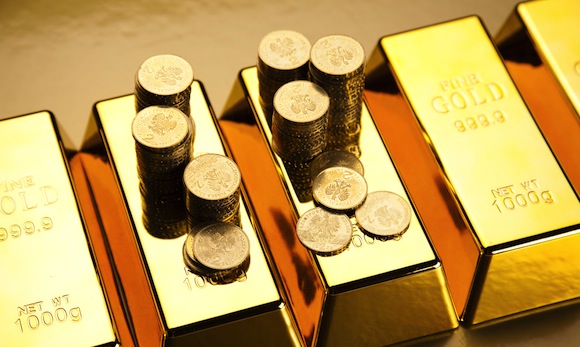My grandfather is rolling over in his grave right now.
He was a proud American. Born on the fourth of July to an Italian immigrant family. He spent most of his life in the U.S. Air Force. He rescued downed airmen in England, went to Eniwetok Atoll for the nuclear bomb tests, and even spent some time in Greenland.
In his later years, he was a craftsman. He built furniture in his spare time. He taught me to run a lathe when I was ten. And he showed me how to build things with care.
More importantly, he was a saver.
I remember getting U.S. savings bonds as a child, with the promise that in a few years, that money would be mine. He saw them to support the country he loved and save for the future.
I'm glad he wasn't here for Jerome Powell's speech today. Because, instead of rewarding us for saving, the chairman of the Federal Reserve is punishing them.
At the same time, he threw the door open wide to a massive bull market.
Here's an excerpt from his speech:
The persistent undershoot of inflation from our 2 percent longer-run objective is a cause for concern. Many find it counterintuitive that the Fed would want to push up inflation. After all, low and stable inflation is essential for a well-functioning economy. And we are certainly mindful that higher prices for essential items, such as food, gasoline, and shelter, add to the burdens faced by many families, especially those struggling with lost jobs and incomes.
In other words, the Fed wants inflation to be around 2%. The simple reason for that is the mountain of debt that the U.S. government added. The only reasonable way out of that hole is to devalue the dollar through inflation.
Inflation means that it takes more dollars to buy somethinglike food, a home, healthcare, etc. That target rate of 2% would be fine, except that the U.S. 10-year bond pays just 0.65%. So, you lose $135 on every $10,000 you park in bonds.
Think about that for a minute. You put $10,000 into a 10-year bond. After 10 years, you cash in the bond and you get $10,766 back. However, with inflation at 2% per year, your purchasing power falls to $8,809.
That's an 18% loss over 10 yearsguaranteed by the U.S. Federal Reserve. And that's at a minimum. Powell said that the Federal Reserve would tolerate even higher rates of inflation.
That goes against everything my grandfather taught me about savings. Walking into a losing position for "safety" is crazy. Especially when we know that there are options.
The safest choice today is to buy gold and silver. And you don't need to hassle with physical metal. There are many "paper" funds that you can buy in your retirement account: SPDR Gold Shares (GLD) for gold and the iShares silver trust (NYSE: SLV) are big, easy and liquid.
The reason we want to own metals is that they go up with inflation. That means we expect $10,000 invested in gold today will be worth $12,000 in a decade, at 2% inflation rate. That's $3,100 more than we can get from a 10-year bond.
That means gold will return 30% more than a bond in this market. And that's just on inflation.
This math is easy to do. Which means many more investors will turn to gold and silver for savings over the next couple of years. And that will push up prices.
I knew gold would hit $2,000 this year. And I won't be surprised if it breaks $2,500 in the next six to twelve months. It must, because it offers real protection for our purchasing power.
I'm sure, if my grandfather were alive, he'd be angry about the dollar and the bond rate. But as a saver, I know he would agree that gold and silver are the best places to put our money, today.
Regards,
Matt Badiali
Matt Badiali is a geologist and independent financial analyst. He spent fifteen years researching and writing about great investments inside the natural resources sectors. He can be reached at www.mattbadiali.net.
| Want to be the first to know about interesting Gold and Silver investment ideas? Sign up to receive the FREE Streetwise Reports' newsletter. | Subscribe |
Disclosure:
1) Statements and opinions expressed are the opinions of the author and not of Streetwise Reports or its officers. The author is wholly responsible for the validity of the statements. Streetwise Reports was not involved in any aspect of the article preparation. The author was not paid by Streetwise Reports LLC for this article. Streetwise Reports was not paid by the author to publish or syndicate this article.
2) This article does not constitute investment advice. Each reader is encouraged to consult with his or her individual financial professional and any action a reader takes as a result of information presented here is his or her own responsibility. By opening this page, each reader accepts and agrees to Streetwise Reports' terms of use and full legal disclaimer. This article is not a solicitation for investment. Streetwise Reports does not render general or specific investment advice and the information on Streetwise Reports should not be considered a recommendation to buy or sell any security. Streetwise Reports does not endorse or recommend the business, products, services or securities of any company mentioned on Streetwise Reports.
3) From time to time, Streetwise Reports LLC and its directors, officers, employees or members of their families, as well as persons interviewed for articles and interviews on the site, may have a long or short position in securities mentioned. Directors, officers, employees or members of their immediate families are prohibited from making purchases and/or sales of those securities in the open market or otherwise from the time of the interview or the decision to write an article until three business days after the publication of the interview or article. The foregoing prohibition does not apply to articles that in substance only restate previously published company releases.





































